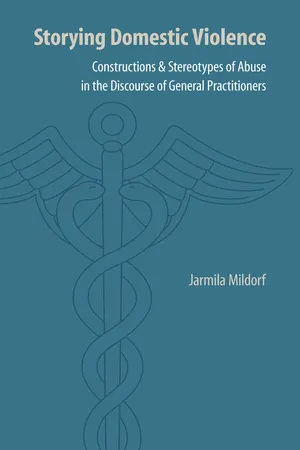
Storying Domestic Violence
Constructions and Stereotypes of Abuse in the Discourse of General Practitioners
- 260 pages
- English
- PDF
- Only available on web
Storying Domestic Violence
Constructions and Stereotypes of Abuse in the Discourse of General Practitioners
About This Book
Globally, at least one in four women experiences domestic violence at some point in her life, according to World Bank figures, which are confirmed by local surveys throughout the world. Since domestic violence can cause both acute physical injuries and long-term chronic illness, an abused woman is likely to appeal to a family doctor or general practitioner as one of her first resources for help. General practitioners, however, rarely report domestic violence in their practices. Jarmila Mildorf's interdisciplinary study makes a unique contribution to the fields of domestic abuse and narrative studies with her analysis of the narrative practices of doctors who treat abused women. Mildorf, a sociolinguist and literary scholar, analyzes the narrative trajectories, space-time parameters, agency, modalities, metaphors, and stereotypes in thirty-six narratives deriving from in-depth interviews with twenty general practitioners in Aberdeen, Scotland. Mildorf shows what these narrative strategies reveal about the perceptions and attitudes of practitioners toward domestic violence and the ways in which the narratives linguistically reconstruct knowledge and realities of domestic violence. Unique in its emphasis on the discourse of doctors, Storying Domestic Violence suggests the possibility of narrative approaches in medical modules that might preclude further stigmatization and victimization of abused women. A cross section of scholars will recognize this study as significant for its potential to change how people think about domestic abuse, physician-patient relations, and public health policy.
Frequently asked questions
Information
Table of contents
- Contents
- Preface
- Acknowledgments
- Transcription Conventions
- 1. Introduction
- 2. Narrative: Theoretical Background
- 3. Domestic Violence and the Role of General Practice: A Narrative-Analytic Approach
- 4. Signs of Abuse: "Classic" Disclosures and Narrative Trajectories
- 5. Setting the Scene of Abuse: Metaphors and Spatiotemporal Mapping
- 6. Mythologizing Time, Mythologizing Violence: Backgrounds and Explanations of Domestic Abuse
- 7. Agents of Their Own Victimization: The Women's Role in the GPs' Narratives
- 8. Evaluating Abuse: Storied Knowledge and Salient Facts
- 9. Conclusion
- Appendix: The GPs' Narratives
- Notes
- Bibliography
- Index